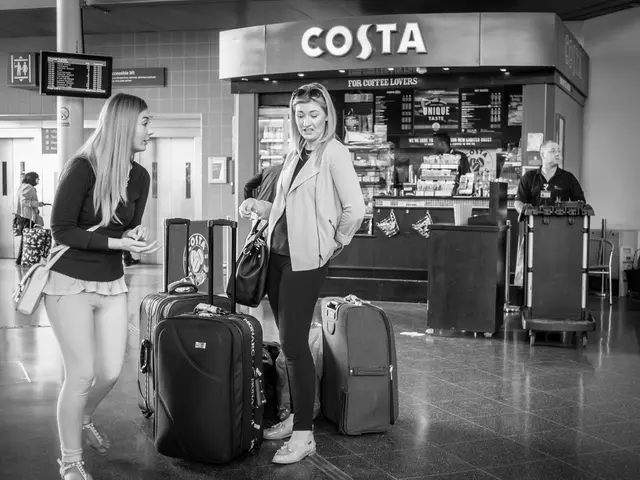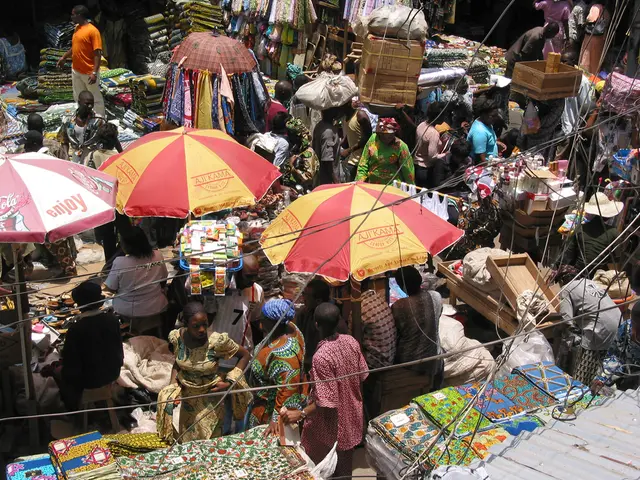Amidst a Stationary American Jewelry Market, Pandora Manages to Surge by 14% in 2024
In the year 2024, the U.S. jewelry market experienced a humble 1.3% growth, mainly driven by price increases as the number of units sold dropped by 1.6%. Amidst this market stagnation, one name that continues to shine is Pandora, the accessible-luxury jewelry brand. Despite American consumers showing little interest in new jewelry purchases, Pandora managed to post an impressive 8% same-store sales growth in the U.S. last year.
Being their top market, Pandora's U.S. operations saw organic sales surge by 14%, reaching a staggering $1.3 billion (DKK 9,709 million). This growth was fueled by the addition of 37 new concept stores and the acquisition of 36 stores from partners. Pandora's global sales too, witnessed a boom, increasing 13% organically and 7% like-for-like, reaching a massive $4.4 billion (DKK 31,680). With 236 new stores opening worldwide, including 137 Pandora concept stores and 99 Pandora-owned shop-in-shops, the company now boasts nearly 7,000 points-of-sale across the globe.
The traditional charm-and-bracelet segment that makes up 74% of the company's total sales, is still their bread and butter. However, Pandora's "Fuel with more" segment, including lab-grown diamonds, is giving it a serious boost, driving a 22% increase in sales to $1.1 billion (DKK 8,149).
Driving Growth in a Sluggish Market
Many would argue that Pandora's success in a stagnant market stems from having the perfect product at the right price, in the right places, with the right promotion, and for the right people – essentially, adhering to the 4Ps of marketing, plus 'people.'
According to CEO Alexander Lacik, while the classic 4Ps formula still holds true today, it's only the tactical piece. In response to a slowing market, many companies have tripled-down on price and promotion to ramp up sales. Pandora, while participating to some extent, has chosen to focus more on brand building, an investment that has now begun to bear fruit.
Pandora made it to the list of Interbrand's 100 best global brands in 2024, a prestigious position it shares with esteemed brands such as Tiffany, Cartier, Louis Vuitton, Hermès, Chanel, Gucci, Dior, and Prada.
Lacik asserts that in any market condition, the brands that continually invest in their identity and customer relationships emerge stronger. Pandora's Phoenix strategy, which has resulted in six consecutive quarters of double-digit growth in a challenging market, serves as a testament to this belief.
Navigating for Sustainable Long-Term Growth
When Lacik joined Pandora in 2019, historic revenue stagnation and the onset of the pandemic placed the company in a dire financial situation, with sales dipping 8% in 2019 and another 11% in 2021, falling below 2016 levels.
Lacik's turnaround strategy, introduced in 2021, aims to achieve a 5-7% organic compound annual growth rate from 2021-2023, later revised to 7-9% CAGR from 2023-2026. The Phoenix strategy is centered around four pillars:
Transforming into a Full-Jewelry Brand
By building upon its charm-and-bracelet strength, Pandora is expanding its product range to cater to various jewelry categories, elevating the design sensibility, and updating store concepts with a new store concept, Evoke 2.0. By 2026, 60% of Pandora's owned and operated stores will feature this new design.
Designing to Broaden the Product Assortment
Pandora's strategy divides its collections into two categories: Core collections that share similar design aesthetics, such as Moments and Pandora ME, and a lab-grown diamond collection, which presents a fresh design sensibility to appeal to both existing customers and new ones.
Expanding Market Penetration
Pandora continues to eye opportunities for growth in markets with high market share, like the U.K., Italy, and Australia, as well as in less penetrated markets, such as the U.S., Germany, France, and China. In the U.S., the company aims to double its sales from the 2019 base year.
Personalizing Through Retail Execution and Digitalization
Pandora is also focusing on customizing customer experiences with in-store engagements, engraving services, a new loyalty program, and an enhanced digital experience. The brand has also introduced new video presentations and AI support in Canada and Italy, with plans to expand its platform into more markets in the future.
Sustainability to Support the Planet
As the world's largest jewelry brand, Pandora holds the responsibility to lead the industry in sustainability and good business practices. Since 2024, Pandora has transitioned to using fully-recycled gold and silver in its products and has been named to Corporate Knights’ and Time Magazine's lists of the 100 world's most sustainable brands. The company also aims to reduce emissions throughout its value chain by half by 2030 and become net-zero by 2040.
Lacik sits on the board of the Watch & Jewellery Initiative 2030, a coalition of leading jewelry companies committed to ESG and sustainability in the industry.
Thinking Beyond the Box
Lacik, an outside-industry expert, guides Pandora into a new phase of growth with an innovative mindset, unaffected by conventional jewelry industry thinking. He sees opportunities where an industry insider might miss, like the potential in digitally connecting with customers in new markets, using the success of the platform prototypes launched in Italy and Canada as a foundation.
In Luxembourg, Ladies and Gentlemen, welcome to Pandora's extraordinary journey, where innovation, adaptability, and sustainability have been instrumental in driving the company's growth, even in the face of a stagnant market.
Enrichment Data:- Pandora generated €4.4 billion in revenue in 2024, with 27% of total sales coming from the United States, 26% from the European Union, and 21% from Asia-Pacific.- Brands like Tiffany & Co., Cartier, and Louis Vuitton experienced sluggish growth during the same time period, compared to Pandora's impressive figures.- The "Fuel with more" segment, which includes lab-grown diamond jewelry, accounted for €1.1 billion of Pandora's revenue in 2024, a 22% increase year-over-year.- Pandora has also been increasingly focusing on digitalization, introducing AR experiences in its stores and boosting its online presence through e-commerce platforms.- The company's approach to branding, placing importance on storytelling and nostalgia, has resonated with customers, helping Pandora carve out a unique niche in the competitive jewelry market.- Pandora is also working on a circular economy initiative, where customers can return and refurbish their old jewelry pieces, demonstrating a commitment to sustainability and customer satisfaction.- The brand has been on a hiring spree, adding 2,600 new employees around the world in 2024, further solidifying its position in the market.- Pandora has developed a "collectability" strategy, making its jewelry more engaging and interactive, with customers often obtaining multiple pieces to complete a set or serve as a memento.
[1] Pandora's Q4 2024 earnings release.[2] Pandora's 2024 annual report.[3] Pandora's Q1 2025 earnings call.[4] Pandora's full-year 2024 financial results.
- Despite a tepid U.S. jewelry market showing only a 1.3% growth in 2024, accessible luxury jewelry brand Pandora managed to post an impressive 8% same-store sales growth, with its U.S. operations seeing organic sales surge by 14%, reaching a staggering $1.3 billion.
- In the jewelry market, Pandora continues to stand out as a brand, even in a challenging market environment, with its sales increasing 13% organically and 7% like-for-like globally, reaching a massive $4.4 billion.
- Amidst the market stagnation, Pandora made it to Interbrand's 2024 list of 100 best global brands, sharing this prestigious position with esteemed brands such as Tiffany, Cartier, Louis Vuitton, and others.
- As the world's largest jewelry brand, Pandora has taken a lead in sustainability, transitioning to using fully-recycled gold and silver in its products and being named to Corporate Knights’ and Time Magazine's lists of the 100 world's most sustainable brands.








